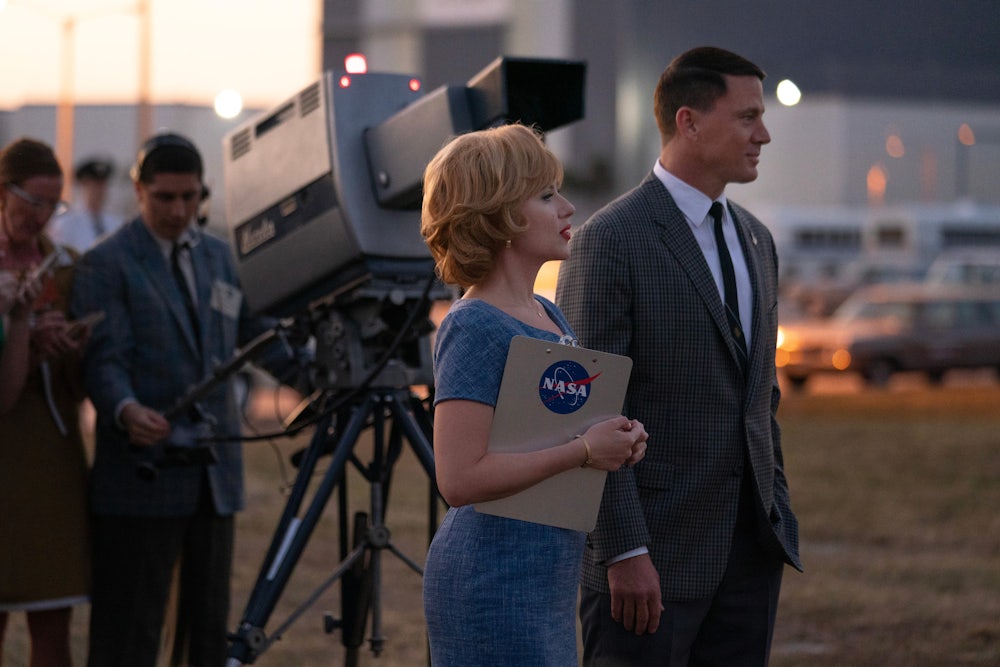American film and television have long imagined the mid–twentieth century as a moment of security and confidence, a time when you could order liberal political consensus with your milkshake at the local Woolworth’s. Movies and shows of the 1990s were especially preoccupied with postwar optimism, presenting their own portraits of progress dosed with nostalgia. Pleasantville gave its characters a respite from the present in the black-and-white world of ’50s sitcom, while Blast From the Past showed a modern woman learning to embrace chivalry from a man raised in a Cold War bunker. The past may not have been perfect in these films, but these narratives offered a comforting illusion of safety, like duck-and-cover drills for the mind.
More recent visions of the midcentury, however, have taken a menacing turn, loudly critiquing the false promise of American prosperity and global dominance. Oppenheimer devoted three hours to the original sin of the nuclear arms race. Amazon’s Fallout, a show set in a postnuclear apocalypse, puts a doomed, retro-futurist twist on the legacies of the Cold War. And while Mad Men luxuriated in the lies that underpin midcentury America at its sexiest and most sellable, last year’s Hello, Tomorrow! takes this premise and heightens it, asking what would happen if a charming Harold Hill–type started selling timeshares on the moon. After all, what could be more representative of the black hole of postwar optimism than a jaunt into outer space?
Marketed as a sassy satire of the space race, Fly Me to the Moon attempts to counter all that negativity. On that front, it arguably over-delivers. It’s 1969, and con artist-turned-advertising executive Kelly Jones (Scarlett Johansson) is blackmailed into working for the federal government. Her mandate is to sell the American people on NASA, but how far will she take her crooked scheming when romance with a decent, broad-shouldered astronaut (Channing Tatum) is on the line?
More than simply a romantic comedy, Fly Me to the Moon is a winking ode to midcentury Americana—a cutesy take on the space race that also suggests a cynicism enshrouding the project. Kitsch and nervy comedy can promise a subtler way to engage with this uneasiness than the full-blown operatics of, say, Oppenheimer. A movie doused in sweetness has the potential to expose postwar triumphalism as a cousin to show business—a kinship that the 1952 Singin’ in the Rain captured with such blackhearted glee. All this irresistible midcentury fakeness sucks us in but can also show us its own artifice and allow us to peer beyond it. That is at least the promise of Fly Me to the Moon—though far from an easy mission to accomplish.
It might be Johansson’s low, Lauren Bacall–esque voice or her old-timey glamour, but she is quickly becoming the patron saint of the midcentury. Last year, she played a depressive actress in Wes Anderson’s atomic age dark comedy, Asteroid City. “Keep telling the story” is the film’s most resonant line, as the actors muddle through staging a play about a stargazing convention in a desert town, complete with UFOs and alien sightings. But the line says just as much about our fixation on midcentury America, noting our perpetual tellings and retellings of its mythologies.
Asteroid City is a stylized play-within-a-play that uses kitschy referentiality to bridge scientific imagination and social history. The film’s mash-up of Western, sci-fi, and Actors Studio–style aesthetics comes together in Anderson’s signature flat affect, mobilized pointedly in this context as a symptom of ennui. If this is midcentury optimism, why is everyone so drained of life? Why is everything, included the extraterrestrial encounter almost an hour in, so stagy, and why does the technology seem so dinky?
Before her role in Asteroid City, Johansson was an Esther Williams–type in the Coen brothers’ Hail, Caesar! A demented reanimation of 1950s Hollywood, this 2016 comedy cosplays the old star system to spoof the magic of the movies as a product of fakers, monsters, and buffoons. It’s not one of the Coens’ major works, but it does what they did best: mercilessly explode any whiff of nostalgia and offer you something nihilistic and silly in its stead.
I came in expecting as much of Fly Me to the Moon, a story about role-play, deception, and the power of the feel-good lie. Kelly Jones is at the top of the advertising game when Moe Berkus (Woody Harrelson) arrives from the White House, demanding she take over marketing for a floundering space program. She flies down to Cocoa Beach, where she meets NASA shot-caller Cole Davis (Tatum). Haunted by his fatal failures on Apollo 1 and unable to go to space himself, Cole is focused on Apollo 11 and the mission to the moon. He is impatient with Kelly’s razzle-dazzle campaigning and political glad-handing, but he’s also more than a little distracted by her green eyes. On the latter front, the feeling is mutual, and their complementary approaches to the mission make them a pretty great team.
Just as their romance starts to heat up, Moe reenters Kelly’s orbit with an order from the top: She must secretly stage a moon landing more impressive, and more manipulable, than the real thing. Sure, he claims this is just backup in case the real mission or the recording fails, but only a sucker takes a fed at his word. Kelly, backed into a corner, hires her favorite director from her commercial days (Jim Rash) and embarks on what they call Project Artemis.
One might imagine the stakes to be sky-high in Fly Me to the Moon, since it involves more than a little heavy machinery, but here genre conventions take precedence. We meet Kelly pretending to be pregnant to land an account, a cute inverse of how Johansson’s character in Hail, Caesar! hides her out-of-wedlock pregnancy to maintain her studio’s morality clause. And while Kelly may have the sexy purr to leave the vaguely churchy Cole tongue-tied, she’s never so forward as to get his tie askew. (Not that he wears a tie. It’s snug knit tops for this guy!) A warm, chatty Ray Romano plays Cole’s friend, fellow NASA engineer Henry Smalls. His only job is to provide narrative exposition so Cole can remain the strong, silent type.
If Tatum’s job was to avoid upstaging Johansson, he nailed the assignment. Their rapport veers between delightfully fizzy, especially when they walk and talk, to aggressively trite. As a character, Kelly has deep, screwball roots: She delights in recasting NASA officials for television interviews, in devising admittedly misleading ad campaigns, in cultivating new alter egos on a moment’s notice. But her lark of a persona is promptly undone by Cole’s sober admonition that “you can win people over just by being who you are,” which can (nay, must) be followed by her textbook, tragic backstory. By the time Johansson delivers the line, “The worst lies are the ones I told myself,” the movie is too earnest to be a pastiche, too wholesome for a spoof.
Fly Me to the Moon ultimately functions as an uneasy mix of different movies. A running gag with a black cat becomes the pretext for ample slapstick, but Cole also has PTSD flashbacks, injecting stabs of tragedy into a comedy that can’t fully accommodate it. Woody Harrelson and Jim Rash seem to be in two very different movies, the former sweaty and threatening, the latter flip and prickly, though both extremes prove compelling to watch on their own terms. It falls to Johansson to tie these varying registers all together, and there is only so much that one actor can do to make that happen.
The movie wants to be a love letter to American inventiveness, expressed on two levels: first, to Apollo 11 and the space landing more generally, and, second, to Cole and Kelly’s third-act scheme to make sure the nation watches the real moon landing in real time. Fly Me to the Moon is ostensibly about keeping the faith in difficult times, but it’s hard not to wish the movie had trusted more in its own fundamental weirdness—that it had embraced the tension between its cynical premise and its romantic execution, and made more of its allegiance, above all, to pageantry over patriotism, as if a Hollywood movie could make any other argument with a straight face.
The twenty-first century is mildly obsessed with the Great Con of American Greatness, with film and television offering bleak fairy tales about hucksters and frauds with increasing enthusiasm. A movie about scams and villains and a corrupt White House, Fly Me to the Moon should fit into this moment but somehow doesn’t.
There is a scene, toward the end, when the “real” moon landing footage is positioned alongside the fake, and Kelly deems the two indistinguishable. At points, the movie takes a passing interest in how fake things seem real and real things seem fake, though it rarely progresses beyond observations like, “The truth is still the truth, even if nobody believes it. A lie is still a lie, even if everybody believes it.” It doesn’t matter if NASA’s space suits look like Halloween costumes: They’re the real deal. It doesn’t matter that Cole and Kelly tell a bigwig a big lie in the service of telling the American public a bigger cosmic truth. Because, again, the truth is still the truth, even if—well, you get it.
The movie’s own framing of real and unreal is too confused to make much of these moments, right from its opening line, “This is the real story … mostly.” NASA, Nixon, and the moon landing are all verifiable historical items. But the characters of Kelly Jones and Cole Davis are about as real as the fake moon landing. The movie explains this away with Moe telling Kelly she’ll be “erased from the history books.” That’s how it would happen, obviously, if this had happened. Which it didn’t. Or did it?! The numerous conspiracy theories that the moon landing was a hoax, including that Dr. Strangelove’s Stanley Kubrick directed the whole thing on a soundstage, are very real, a source of comedy in the screenplay and likely inspiration for the entire film.
It’s tempting to imagine the different forms this film might have taken, not only because the movie is a counterfactual daydream, but also because of the intriguing changes it underwent in development. What else might this movie have been, if, for example, it had remained titled Project Artemis and leaned into being a solo vehicle for its actress-producer? What if Jason Bateman had stayed on as director, instead of departing the project in 2022 due to “creative differences”? (Bateman, at the helm of Bad Words and The Family Fang, has a darker sense of humor than the director who replaced him, Greg Berlanti.) What if Chris Evans, who was originally cast, had played the romantic lead, or Tatum had been directed differently?
Fly Me to the Moon’s repeated mentions of Kubrick underscore what might have been the movie’s best iteration. A second coming of Dr. Strangelove was never in the cards, and it didn’t need to be. But the allusion to that 1964 classic is a reminder that there can be something revealing in the mode of parody, in the excesses of exaggeration. Somewhere between the Technicolor nostalgia of period storytelling and the ashen aesthetic of depressed retrofuturism, lies satire. It’s a tricky balance, but it’s not rocket science.




